The Complete Tatsuo Shimabuku
by Victor Smith
Bushi no Te Isshinryu
Introduction
On January 15, 1956, Tatsuo Shimabuku founded Isshinryu
Karate. Shortly after that time, Tatsuo Shimabuku
began teaching his karate to the U.S. Marines stationed
on Okinawa. While the income he received from the
Marine Corps was a financial windfall to him, his
efforts caused the Isshinryu system to be spread across
the United States and the world in the 50's and 60's.
This was one of the pioneering efforts spreading karate
to a larger world.
Tatsuo Shimabuku began his own studies in Okinawa
about 1916 at the age of eight, and they continued
with such noted Okinawan instructors as Chotoku Kyan
(one of the major instructors of Shorin-ryu), Chojun
Miyagi (the founder of Goju Ryu karate), Chokoi Motobu
(another major Okinawan instructor in the Shorin tradition)
and Taira Shinken (a major instructor of kobudo -
Okinawan Weapons).
The Isshinryu system, as created by Tatsuo Shimabuku
, drew on all of these sources. Unfortunately the
story of the experiences Shimabuku Sensei gained with
his instructors has not been saved.
As I've pursued a long-term interest in all of Okinawan
Karate, my review of historical information about
these men slowly revealed a view of those earlier
years. From this research I've created four studies
on Tatsuo Shimabuku's instructors.
I believe this creates a fuller history of those
instructors and their likely contributions to Shimabuku.
This history of several of Okinawa's major instructors
in the 1900's also highlights some of the trends,
which developed in Okinawa. I believe all contemporary
martial artists need to consider the transmission
of these arts from those days. Their impact reverberates
with us still.
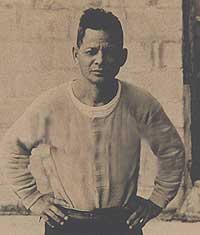
Part One: The Kyan Influence
For some time as I read much written about Isshinryu
and Tatsuo Shimabuku, I haven't felt we've been looking
at the entire man. Instead it seems as if Shimabuku
Tatsuo sprang forth and gave us Isshinryu. His instructors
are mentioned but I don't feel we've looked closely
enough at the impact of the environment which fostered
the founder of Isshinryu.
Let me draw an analogy. Each martial artist does
represent himself, his capabilities, the work he's
done, and his own intentions. At the same time you
can view the group of students of an instructor and
find a commonalty, too. Many times I've seen an instructor
at a tournament who has a distinctive style to his
technique, and later through the day, see his students
perform and immediately identify their instructor
from the commonalty they share.
Every instructor is and always has been a product
of his own instructor(s), his contemporaries and his
environment. Recently I've been trying to understand
the environment surrounding Tatsuo Shimabuku.
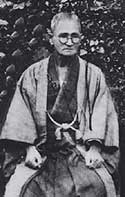 I
believe the most important place to start is his relationship
with Chotoku Kyan. It was with Kyan that Tatsuo Shimabuku
spent the most time. A great deal of the Kata of Isshinryu
originated with his training with Kyan, and in the
late 1940's to early 1950's, he called his system
Chan Migwha Te - using the nickname that had been
given to Kyan Sensei. As a starting point I refer
to John Sells text "Unante - - The Secrets of
Karate." On page 184, we begin to get a vision
of the background of Kyan. I
believe the most important place to start is his relationship
with Chotoku Kyan. It was with Kyan that Tatsuo Shimabuku
spent the most time. A great deal of the Kata of Isshinryu
originated with his training with Kyan, and in the
late 1940's to early 1950's, he called his system
Chan Migwha Te - using the nickname that had been
given to Kyan Sensei. As a starting point I refer
to John Sells text "Unante - - The Secrets of
Karate." On page 184, we begin to get a vision
of the background of Kyan.
"One old karateka who can be credited with preserving
some of the kata of Tomari was Chotoku Kyan. This
student of so many great masters disseminated in his
time the tomari-chonto, wansu and several versions
of the tomari passai. Kyan introduced ananku kata
into Okinawan Karate. He also taught seisan, gojushiho
and seisan as learned from Matsumura, as well as Yara's
kusanku kata. Of course each form has Kyan's own innovative
stamp. This brings to light the fact that most of
the old masters taught kata differently at different
times in their lives. They also sometimes taught dissimilar
versions to different students. Because of this factor
we now have a plethora of variations of all the above
kata. While this "kata customization" is
often associated with Kyan, the same could be said
of Matsumura himself and certainly too, of Kyan's
contemporary, Funakoshi."
Remember what a small place Okinawa was. Without
doubt Kyan's students saw their instructor's forms
were differing from others who had trained under Kyan's
instructors. So issues about Tatsuo Shimabuku changing
the nature of his kata and technique at different
times was most likely the a continuation of Karate
training as he and the others in Okinawa experienced
with Kyan.
Of course this was noted in Okinawa. The great karate
master and founder of goju ryu karate, Chojun Miyagi(McCarthy
"Ancient Okinawan Martial Arts-2," page
67 on The 1936 Meeting of the Okinawan Karate Masters),
is quoted as saying, "Shorin-ryu's fundamental
training [kihon] and open-handed techniques [kaishu]
are not taught in any clearly defined way. However
the Shorei-ryu's kaishu and kihon are taught according
to a clearly established method. My teacher taught
us according to the Shorei-ryu method."
While I can interpret his words as a commentary on
the Shorin teaching methods, it's also interesting
to see 'sniping' from 1936 too. We have no lock on
the flame wars today!
I find it interesting that this was the template
against which Tatuso Shimabuku was taught. Whether
those changes occurred while he was training with
Kyan Sensei, or he whether he observed them as he
saw others on occasion who trained with Kyan Sensei,
the fact of the existence of change could not have
been ignored.
Just the other day I was reviewing tapes from a number
of Kyan derivative forms. Whether Bunei Okuhira, or
Zempo Shimabukuro (son of Shimabuku Zenryo) or Shoshin
Nagamine, there is a great deal of similarity between
them as well as many differences. Bunei Okuhira and
Shoshin Nagamine were direct students of Kyan, as
was Tatsuo Shimabuku Sensei. Zenryo Shimabuku was
also a direct student of Kyan.
I note the more advanced their forms (such as Chinto,
Kusanku and Gojushiho), the greater the similarity
to my eye. This is something I've noticed between
various Isshinryu groups, on occasion. The differences
between Seisan and Seiuchin kata are greater than
the differences between Chinto and Kusanku. I've always
thought this was because the instructor spends more
time teaching the beginning forms and less time on
the advanced forms. If changes creep in, it would
be logical to assume they would occur on those taught
most frequently.
This is not a scientific move by move comparison,
but an impression/opinion observation to my eye.
Returning to John Sells "Unante" we find
some information regarding Kyan Sensei's course content
on page 189:
"To explore kata even further however, Chotoku
Kyan, a contemporary of Funakoshi and Mabuni should
be compared. It was around 1930 that Kyan published
a series of forms under the heading "Seven Original
Kata of the Ancient Style." The forms listed
therein were:
|
Wanshu
Ananku
Kusanku
Chinto
Passai
Useishi
Naifanch"
|
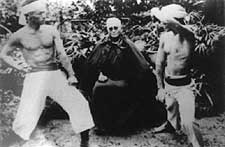 |
Consider how much of this became the
Isshinryu curriculum, directly or indirectly.
Wanshu (Wansu), Kusanku, Chinto and Niafanchi from
Isshinryu most likely originated here. I would note
Wanshu (Wansu) is the most heavily modified of the
Kyan forms with knee strikes, side kicks and front
kicks not found in the other kata.
It is reported at one time Shimabuku Sensei taught
Passai amd Ueishi (Gojushiho), and portions of those
forms are included in his SunNuSu kata.
The kata ananku isn't included in the Isshinryu curriculum,
but as I teach one version of same (Ezio Shimabuku's
). I suspect it was because most of the techniques
in the form are found in the other Isshinryu forms.
Another aspect to consider is the development by
Kyan of the vertical punch. Nagamine's book 'Tales
of Okinawa's Great Masters by Shoshin Nagamine,' on
page 89 has a nice section on the life of Kyan.
"Because of his tiny size, Sensei spent considerable
time and effort developing his jodan-tsuki (rising
punch). Never having altered this technique, Kyan's
jodan-tsuki represented his own interpretation of
using the strike in a practical way for a person of
his size. It can be said that his unique jodan-tsuki
exists in no other ryuha and must therefore illustrate
his own understanding of karate-do."
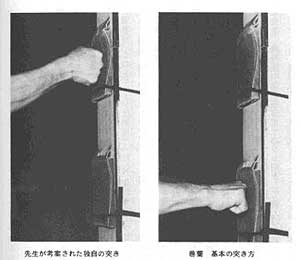
Accompanying photographs show a traditional turning
punch striking a makiwara and a vertical punch striking
a makiwara. The latter was described as "Kyan's
original punch."
I would believe it likely Tatsuo Shimabuku may have
used his instructor's teachings as the source of his
choice of the vertical fist.
The final observation I would like to make on the
teaching of Chotoku Kyan is what his students did
with his instruction. John Sells in 'Unante' lists
the following individuals as his students:
- Kori
Hisatake
-
Joen Nakazato
-
Zenryo Shimabuku
-
Taro Shimabuku
-
Tatsuo Shimabukuro
-
Eizo Shimabukuro
-
Tsuyoshi Chitose
-
Ankichi Arakaki
-
Shoshin Nagamine
-
Bunei Okuhir
|
 |
At least 7 of them became instructors
in their own right and developed their own systems.
While Chotoku Kyan taught his art, he apparently
did not try to establish a single system. That seems
right to me, as I'm unaware of any real effort to
do this in those earlier days. I believe this is an
important aspect affecting the development of all
Okinawan karate.
And while there is a great deal of similarity between
these instructors' forms and techniques, there are
also a great many differences at the micro level,
if not the macro level.
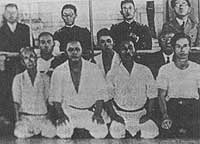 If
I recall correctly Patrick McCarthy has written on
the fact that the concept of organization was imported
to Okinawa by the Japanese. Without doubt, their penchant
for organization created the first large international
karate organizations. Thus the teaching template Shimabuku
Sensei observed most likely was that of instructing
your students so that they would go out on their own.
There does not seem to be a regulating mechanism to
pass along changes or control the 'correct form' of
the system. Does not the same situation seem to reside
in the changing system of Shimabuku Sensei? If
I recall correctly Patrick McCarthy has written on
the fact that the concept of organization was imported
to Okinawa by the Japanese. Without doubt, their penchant
for organization created the first large international
karate organizations. Thus the teaching template Shimabuku
Sensei observed most likely was that of instructing
your students so that they would go out on their own.
There does not seem to be a regulating mechanism to
pass along changes or control the 'correct form' of
the system. Does not the same situation seem to reside
in the changing system of Shimabuku Sensei?
I believe reflection on these aspects of the karate
of Kyan shows they may well have influenced the decisions
to the developing art of Isshinryu of Tatsuo Shimabuku.
There are many parallels between Kyan's choices to
those made by Shimabuku Sensei.
Select Reading:
Unante - The Secrets of Karate by John Sells
Pub. W.M.Hawley 1995
Tales of Okinawa's Great Masters by Shoshin
Nagamine Pub Tuttle 2000
Ancient Okinawan Martial Arts - Koryu Uchinadi
2 by Patrick McCarthy Pub Tuttle 1999

back
to top
home
| about
us | magazine
| learning
| connections
| estore
|